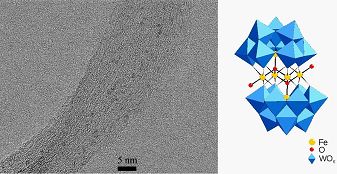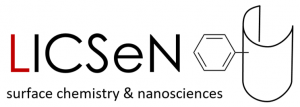Single molecule magnets grafted on carbon nanotubes : the first of its kind has been realized at the Molecular Chemistry and Materials Institute in Orsay (CNRS/University of Paris 11) in collaboration with the Institut Lavoisier de Versailles (CNRS/Université de Versailles Saint-Quentin), the Laboratoire de Chimie Physique (CNRS/Université Paris 11), the Molecular Electronics Laboratory (CEA-Saclay/SPEC) and the Néel Institut in Grenoble (CNRS/Université Joseph Fourier). These novel systems are of great interest to both physicists; because of their capability to store binary information (on and off) on individual small molecules (~ 2nm) and chemists ; because of the remarkable acceleration in the electron transport between the electrodes and the polyoxometalate* observed in the system, foretelling new catalytic properties. These results have been published in the June 2nd edition of Agnewandte Chemie.
Molecular nanomagnets (or molecular magnets) are coordination chemistry complexes that posses a magnetic bistablity (memory effect) ; that is, their magnetic properties change under external perturbations (switching from one magnetic state to another ). Presently, magnetic bistability has been observed at the level of a crystal containing a large number of molecules. When individual molecules are isolated, however, they may no longer retain such bistability. One of the important challenges involved in building the model single-molecule memory storage devices is to conserve the magnetic bistablity at the level of isolated single molecules.
For the first time, the researchers have succeeded in assembling a Fe6-polyoxometalate molecular magnet on a carbon nanotube while maintaining the chemical integrity as verified by the electrochemical study. The molecules are isolated from one another and the magnetization measurements taken with a micro-SQUID** reveal that their magnetic bistability is conserved. Furthermore, the surrounding presence of carbon nanotubes could facilitate the addressing of individual molecules (manipulating the magnetic moment of each molecule to switch from one state to another) owing to the synergy between the electronic property of the nanotubes (semiconductors) and the magnetic property of the molecular magnets. Withal, one could imagine a device capable of the magnetic moment manipulation and the read-out to perform quantum operations.
In an entirely separate domain, electrochemistry studies have shown that the grafting of a Fe6-polyoxometalate molecule on to a nanotube surface produces a remarkable acceleration of electron transfer between the electrodes and the polyoxometalates. Invoked reason is that the stability of the nanotube/polyoxometalate hybrid system together with the presence of the carbon nanotube, reinforce the interaction between the electrode and the molecule, enhancing the electron transfer between the two as a result. This behavior opens encouraging perspectives, notably in the field of electrocatalysis, for the study of new catalytic properties… to be continued.

(*) The polyoxométallates (POM) are composed primarily of metals (molybdenum and tungsten) and oxygen.
(**) A micro-SQUID (Superconducting Quantum Interference Device) is a micro-meter sized high sensitivity magnetometer for measuring extremely weak magnetic fields in small objects.
Référence :
Magnetic Bistability of Individual Single-Molecule Magnets Grafted on SWNTs
A. Giusti, G. Charron, S. Mazerat, J.D. Compain, P. Mialane, A. Dolbecq, E. Rivière, W. Wernsdorfer, R.N. Biboum, B. Keita, L. Nadjo, A. Filoramo, J.-P. Bourgoin, T. Mallah,
Angew. Chem. Int. Ed., 48(27) (2009) 4949.





